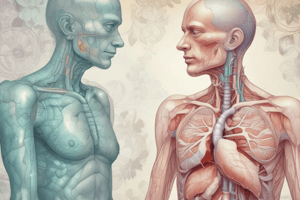Podcast
Questions and Answers
What is the likely diagnosis for a newborn with normal breathing and pulse but has a blue torso and extremities?
What is the likely diagnosis for a newborn with normal breathing and pulse but has a blue torso and extremities?
- Respiratory failure
- Central cyanosis (correct)
- Cardiomyopathy
- Bronchiolitis
What is the primary cause of bronchiolitis in children?
What is the primary cause of bronchiolitis in children?
- Viral infection (correct)
- Genetic disorder
- Allergic reaction
- Bacterial infection
What is the normal heart rate for teenagers?
What is the normal heart rate for teenagers?
- 100-140 beats/min
- 70-120 beats/min
- 60-100 beats/min (correct)
- 50-70 beats/min
What is the recommended fluid dosage for pediatrics?
What is the recommended fluid dosage for pediatrics?
What is the primary risk factor for cardiomyopathy in pregnant females?
What is the primary risk factor for cardiomyopathy in pregnant females?
What is the importance of knowing the number of live births in a woman's pregnancy history?
What is the importance of knowing the number of live births in a woman's pregnancy history?
What is the common finding in premature newborns?
What is the common finding in premature newborns?
What is the full-term gestation period?
What is the full-term gestation period?
Which of the following is a common ventilation issue in newborns?
Which of the following is a common ventilation issue in newborns?
What is the primary cause of bradycardia in newborns?
What is the primary cause of bradycardia in newborns?
What is the correct order of steps when delivering a newborn?
What is the correct order of steps when delivering a newborn?
What is the purpose of thermoregulation in the body?
What is the purpose of thermoregulation in the body?
Why is it important to have the parents nearby when assessing a pediatric patient?
Why is it important to have the parents nearby when assessing a pediatric patient?
What is a common sign of pneumothorax in an infant?
What is a common sign of pneumothorax in an infant?
What is the correct sequence for suctioning a newborn's nose and mouth?
What is the correct sequence for suctioning a newborn's nose and mouth?
Why is it important to check for a nuchal cord during delivery?
Why is it important to check for a nuchal cord during delivery?
Flashcards are hidden until you start studying
Study Notes
Central Cyanosis
- Defined as a blue discoloration of the torso and extremities, indicating hypoxia
- May occur in newborns with normal breathing and pulse rates
- Treatment involves providing blow-by oxygen, warm blankets, and skin-to-skin contact if possible
- If the patient is apneic or has a pulse rate less than 100, start Positive Pressure Ventilation (PPV)
Bronchiolitis
- Defined as an inflammation or swelling of the small airways in the lower respiratory tract due to viral infection
- Can be difficult to differentiate from asthma, but the patient's age is a key clue (children under 1 year old are more likely to have bronchiolitis)
- Common symptoms include wheezing, tachypnea, retractions, and mild hypoxia
Pregnancy and Childbirth
- A woman can become pregnant after starting her menstrual cycle
- Premature newborns are at increased risk for heart defects, low birth weight, and lung issues
- Common causes of premature birth include maternal narcotic use and multiple pregnancies
- Normal heart rate for teenagers is 60-100 beats per minute
- Normal gestation period is 40 weeks
Pediatrics and Neonate Care
- Fluid dosage for pediatrics: 20ml/kg
- Fluid dosage for neonates: 10ml/kg
- Assessment differs from adults in that pain is assessed last in pediatric patients
- Having parents nearby can help comfort inconsolable pediatric patients
Cardiomyopathy in Pregnancy
- Defined as a form of heart failure that occurs in the last trimester of pregnancy or postpartum
- Risk factors include obesity, multiple pregnancies, and African American descent
- Symptoms include smoking, alcoholism, poor nourishment, persistent hypertension, pulmonary edema, pedal edema, hypotension, diaphoresis, and tachycardia
Eclampsia
- High-risk patients include those under 18 and over 35
- Assessment findings include ketones in the urine, pedal edema, headache, and dizziness
- Symptoms include hypertension and seizures
Pneumothorax in Infants
- Causes include meconium inhalation, infection, or aggressive PPV
- Symptoms include non-responsiveness to PPV, unilateral absent breath sounds, and shifted heart tones on the left side
Newborn Care
- During delivery, support the head and do not pull
- Check for a nuchal cord and gently guide the head to deliver the shoulders
- Dry and suction the baby's nose and mouth with sterile gauze and bulb syringe
- Cut the cord 4 inches from the baby's navel, 2 inches from that, and cut in between when no longer pulsating
Ventilation Issues in Newborns
- Most common issue: ineffective BVM seal and head position
- Other possible causes: secretions, pneumothorax, and equipment malfunction
Bradycardia in Newborns
- Most common cause: hypoxia, which responds well to PPV
- Other possible causes: hypovolemia, hyperthermia, pneumothorax, head injury, maternal drug use, hypothyroidism, and acidosis
Thermoregulation
- Defined as the process by which the body maintains temperature through heat gain and loss
- Important in newborn care to prevent hypothermia and hypothermia-related complications
Studying That Suits You
Use AI to generate personalized quizzes and flashcards to suit your learning preferences.




